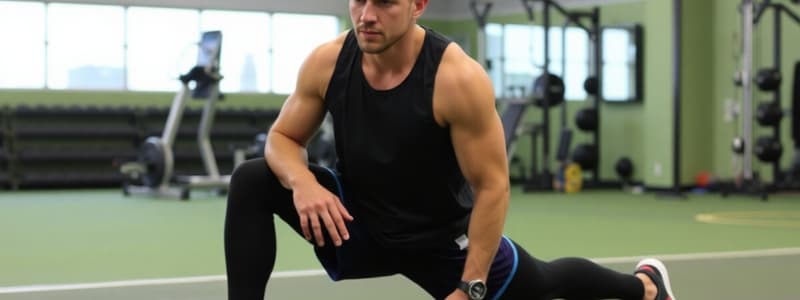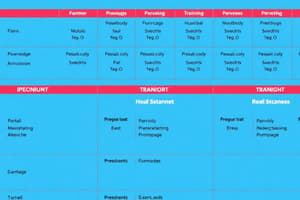Podcast
Questions and Answers
What is the recommended number of sets per exercise for novice and moderately trained individuals to improve their capacity?
What is the recommended number of sets per exercise for novice and moderately trained individuals to improve their capacity?
- 2-4 sets (correct)
- 4-6 sets
- 1-2 sets
- 8-10 sets
High training frequency does not significantly contribute to muscle hypertrophy.
High training frequency does not significantly contribute to muscle hypertrophy.
False (B)
What two factors are inversely related when it comes to training volume and intensity?
What two factors are inversely related when it comes to training volume and intensity?
Volume and intensity
The formula for calculating volume in weight training is _____ = sets x reps x weight.
The formula for calculating volume in weight training is _____ = sets x reps x weight.
Match the following training performance metrics with their definitions:
Match the following training performance metrics with their definitions:
Which factor is NOT typically considered in a needs analysis for sport performance?
Which factor is NOT typically considered in a needs analysis for sport performance?
The exercise order in a training program should always prioritize isolation exercises before compound exercises.
The exercise order in a training program should always prioritize isolation exercises before compound exercises.
What does '1 RM' stand for in strength training?
What does '1 RM' stand for in strength training?
During training, it is important to consider the _______ of exercise to ensure adequate recovery.
During training, it is important to consider the _______ of exercise to ensure adequate recovery.
Match the following terms with their definitions:
Match the following terms with their definitions:
Which type of exercise focuses on large muscle mass and is multi-joint?
Which type of exercise focuses on large muscle mass and is multi-joint?
Core exercises primarily focus on single joint movements.
Core exercises primarily focus on single joint movements.
What should you aim for in rest periods when training for power?
What should you aim for in rest periods when training for power?
The contraction type that includes both concentric and eccentric is called ______.
The contraction type that includes both concentric and eccentric is called ______.
Match the type of training goal with the typical repetition range:
Match the type of training goal with the typical repetition range:
Which resistance mode is characterized by the use of body weight?
Which resistance mode is characterized by the use of body weight?
High velocity training is primarily aimed at increasing muscular endurance.
High velocity training is primarily aimed at increasing muscular endurance.
In strength training, what is the primary focus of injury prevention?
In strength training, what is the primary focus of injury prevention?
Flashcards are hidden until you start studying
Study Notes
Exercise Selection Issues
- Specificity: The type of exercise should match the specific needs of the sport or activity. This can be General (front squat), Special (clean pulls) or Specific (loaded jumps)
- Core vs Assistant Exercises: Core exercises involve multiple joints and large muscle groups (e.g., Squat). Assistant exercises focus on single joints and smaller muscle groups (e.g., Bicep curl). Prioritize core exercises for performance-oriented programs.
- Performance vs Prehab: Performance training focuses on high force and velocity to enhance performance. Prehab prioritizes structural integrity, agonist/antagonist balance, movement quality, and injury prevention.
- Resistance Mode and Contraction Type: Different resistance modes include free weights, machines, body weight, and resistance bands. Contraction types include:
- Isoinertial: Concentric, Eccentric, Concentric-Eccentric
- Isometric: Static muscle contraction
- Isokinetic: Constant speed of movement
- Movement Velocity:
- High Velocity: Explosive movements for power development.
- Low Velocity: Controlled movements to optimize time under tension and improve strength.
- Attempted Acceleration: Gradual increase in speed as stability improves.
Rest Periods
- Muscular endurance: 3 minutes of rest
- Power exercises: > 3 minutes of rest
Repetitions
- Approximate Repetition Ranges (2-5 sets):
- Hypertrophy: 6-12 repetitions (Beginner), can be less (Advanced)
- Strength: 6-10 repetitions (Beginner), 1-6 repetitions (Advanced)
- Power: 1-6 repetitions (Heavy) & 6-12 repetitions (Light)
- Strength Endurance: 10-20 repetitions
- Control/Stability: 30-60 seconds / 5-15+ repetitions
Volume & Intensity
- Inverse relationship between volume and intensity: As volume increases, intensity decreases, and vice versa.
- Intensity prescription methods:
- Maximum load lifted for a specified number of repetitions
- Percent of 1 Rep Max (RM) load:
- Testing: Directly testing 1RM.
- Prediction equations/tables: Use formulas to estimate 1RM.
- Volume is not always equal: The quality of the exercise and the individual's training experience influence the effectiveness of volume.
Individual Needs Analysis
- Training age vs Chronological age: Consider an individual's experience in training.
- Long-term and Short-term performance needs: Identify the specific goals of the training program.
- Performance limitations: Assess areas that need improvement, including:
- Range of motion (ROM)
- Stability and balance
- Strength
- Power
- Strength endurance
Validity & Reliability
- Valid and reliable tests: Use objective tests to measure performance and evaluate progress.
Tracking Performance
- Stability and Range of Motion: Track progression in these areas.
- 3RM: Track the individual's 3 Rep Max in various exercises.
- MaxPowerSJBW, Rel CMJ Power, MaxPowCMJ40, MaxPowerSJ40, MaxPowCMJBW: Track these performance metrics to identify areas of improvement.
Determining Individual Limitations
- Assess both performance and the underlying strength and power qualities that contribute to that performance.
- Example:
- 20m sprint: Performance measure
- 1RM squat: Underlying strength
- BW SQJ: Underlying power
- BW CMJ: Underlying power with stretch-shortening cycle (SSC) contribution
Exercise Order
- General guidelines:
- Power before strength
- High velocity before low velocity
- Compound before isolation
- Other possibilities:
- Circuits
- Supersets (compound, upper/lower, agonist/antagonist)
- Agonist/antagonist
- Upper body/lower body
- Pre-exhaustion
Maximum Strength Program Example
- Example exercise order for a maximum strength program:
- Deadlift
- Dumbbell bench press
- Single-leg squat
- Dumbbell row
- (Additional exercises as needed)
Studying That Suits You
Use AI to generate personalized quizzes and flashcards to suit your learning preferences.




